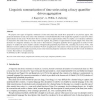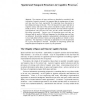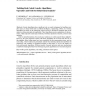797 search results - page 29 / 160 » Spatial Relations Analysis by Using Fuzzy Operators |
FSS
2008
13 years 7 months ago
2008
We propose new types of linguistic summaries of time-series data that extend those proposed in our previous papers. The proposed summaries of time series refer to the summaries of...
BIRTHDAY
1997
Springer
14 years 1 months ago
1997
Springer
The structures of space and time are identified as essential for the realization of cognitive systems. It is suggested that the omnipresence of space and time may have been respons...
PAKDD
2009
ACM
14 years 6 months ago
2009
ACM
Detecting changes in spatial datasets is important for many fields. In this paper, we introduce a methodology for change analysis in spatial datasets that combines contouring algor...
PIMRC
2008
IEEE
14 years 3 months ago
2008
IEEE
—Wide spread adoption of mobile Internet services will increase the demand for low cost high capacity wireless networks. Cooperation between different types of operators will ena...
AIR
1998
13 years 8 months ago
1998
Abstract. Genetic algorithms play a significant role, as search techniques for handling complex spaces, in many fields such as artificial intelligence, engineering, robotic, etc...



